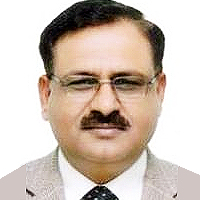Tunable induced transparency and Fano-resonance in double cavity optomechanical system
Published on: 7th April, 2021
OCLC Number/Unique Identifier: 9026724935
We analyze optomechanically induced Transparency and asymmetric Fano-line shape Profile in a two-mode cavity system, coupling at weak and strong coupling regimes. The model system consists of one mechanical mode and two optical modes. The transmission shows nonreciprocal behavior. Both the forward transmission and backward reflection for the system are analyzed for both optic-optic and mechanical-optic cavities by considering various system parameters. The output spectra lead to sharp asymmetric Fano-resonance and tunable transparency. Double line-shape profile is observed in the output Spectrum. Our proposal provides a new platform for application in quantum telecommunications and a photonic device like optical Switches.
Senile Cataract
Published on: 2nd February, 2024
Cataracts may be described as the opacity of crystalline lenses present in the eye. The translucent crystalline lens is a part of the human eye. It possesses all the physical characteristics of a biconvex lens. The eye’s lens performs similar functions to a camera’s lens. The lens directs light rays entering the eye to the retina’s sensitive layers. Any factor that increases the absorption of scattering of light by the lens reduces its transparency. The opacity of the lens or its capsule, whether developmental or acquired, is called a cataract. Cataracts vary in degree of density and site and assume various forms. Cataract is the leading cause of reversible visual impairment and blindness globally. There are several classifications of cataracts based on morphologic and/or etiologic criteria. However, in epidemiologic studies, the simplified system of three types based on localization of lens opacities is most commonly used: Nuclear cataract is the most common type, followed by cortical cataract and posterior subcapsular cataract. This most prevalent form of acquired cataract, also known as an “age-related cataract,” affects people of both sexes equally and typically develops after age 50. More than 90% of people experience senile cataracts by age 70. Although one eye is almost always afflicted before the other, the disorder is typically bilateral. In the available literature, there is no mention of any such drug that could reverse the opacity of the lens (cataract) once it occurred and make it clear and transparent again.Only replacement of opaque lenses with artificial transparent Intraocular lens (IOL) is successful treatment of cataracts. This review focuses on senile cataracts and the best possible management of senile cataracts.
Harmonizing Artificial Intelligence Governance; A Model for Regulating a High-risk Categories and Applications in Clinical Pathology: The Evidence and some Concerns
Published on: 18th March, 2024
The Canadian healthcare system, grappling with issues like systemic and intelligently established structural anti-black racism, including indigenous nations; even within Pathology and Laboratory Medicine Communities: and deteriorating outcomes, sees potential in AI to address challenges, though concerns exist regarding exacerbating discriminatory practices. In clinical pathology, AI demonstrates superior diagnostic accuracy compared to pathologists in a study, emphasizing its potential to improve healthcare. However, AI governance is crucial to navigating ethical, legal, and societal concerns. The Royal College of Physicians of Canada acknowledges the transformative impact of AI in healthcare but stresses the need for responsible AI tools co-developed by diverse teams. Despite positive attitudes towards AI in healthcare, concerns about patient safety, privacy, and autonomy highlight the necessity for comprehensive education, engagement, and collaboration. Legal concerns, including liability and regulation, pose challenges, emphasizing the need for a robust regulatory framework. AI application in healthcare is categorized as high-risk, demanding stringent regulation to ensure safety, efficacy, and fairness. A parallel is drawn to drug regulation processes, suggesting a similar approach for AI. The lack of transparency in AI-based decision-making raises ethical questions, necessitating measures to address biases and ensure patient privacy. Social accountability is crucial to prevent AI from exacerbating health disparities and harming marginalized communities. In conclusion, while AI offers potential benefits in clinical pathology, a cautious approach with comprehensive governance measures is essential to mitigate risks and ensure ethical AI integration into healthcare.
Complications of External Otitis in Horses
Published on: 21st May, 2024
The physiological removal of foreign bodies in the horse’s external ear canal is best achieved by head-shaking. However, external otitis in the horse induces moderate to severe pain: therefore, the horse does not shake his head. The causes of external otitis are dust, water in the external ear canal, keratin, and ceruminous debris. The clinical symptoms are ear discharge, skittishness, facial nerve paresis, and/or head tilt. After the horse has been sedated, the most important diagnostic procedure is the endoscopy of the cartilaginous and osseous part of the external ear canal, including the evaluation of the transparency of the tympanic membrane. The clinical complications of external otitis are hearing loss, facial nerve paresis, head tilt, hypertrophy of the tympanostylohyoideum, and corneal ulcers. The most important treatment is soaking up the exudate in the osseous part of the external ear canal using small cotton balls which are held by the foreign body forceps of the endoscope. Based on the results of the culture of exudate and the antibiogram, an antibacterial drug must be administered orally for 3 to 4 weeks. At this time, an endoscopy of the external ear canals and guttural pouches also has to be done. Based on the outcome of the endoscopy, endoscopic and clinical investigations have to be performed six months later as well. Only 7/19 horses had a normal osseous part of the external ear canal with a transparent tympanic membrane, including normal hearing measured by the brainstem auditory-evoked response after one month of treatment.
Wealth in Water: A Blueprint for Sustainable Global Ocean Research
Published on: 19th June, 2024
Pushing forward with leveraging water resources, promoting international cooperation, and ensuring transparency in deep-sea mining operations. There is also a concern about where to discharge the toxins of unpurified water. Artificial Intelligence has created a dominance in the applications field with a totally automated system.Out of a thorough analysis completed with indicators, satellite radar, and A Journals, there are 30 years of research and 8 years of monitored testing to achieve accuracy and relevance. The patents in place are, Oceanic Mining System (4446636), Flexible Solar Skin in Combination with an Airplane (4768738), Cargo Torpedo (4421050), Oceanic seaplow system (4398362), and previous articles like “Is Extracting Lithium and deep-sea mining more sustainable?”, “AI as a Means of Water Purification Protection”, “Global Water Distribution”, and “Can Deep Sea Water be Processed into Potable Water and Distributed into the Middle East’?To report some ballpark numbers on the proposal and how we would navigate these projects, there will be an exact location of where the plant will be built as well as a water/salinity report of the water being treated. There are still issues with analyzing the cost of desalination compared to other alternatives. Deep Sea Water proves to be a higher quality water and the investment is well worth it. The surveys lean toward clients preferring the International Standards Operating Procedure. All recipients agree there should be a sense of urgency on water shortages. Currently, AI has proven to be a vital asset in eliminating biases and expenses.
The Police Power of the National Health Surveillance Agency – ANVISA
Published on: 27th December, 2024
The National Health Surveillance Agency (ANVISA) is a public institution created by Law 9782/1999, which integrates the field of Collective Health and acts in the prevention, control, and inspection of sanitary conditions in various sectors, such as food, health, pharmacies, hospitals, and commercial establishments. Its main objective is to guarantee the protection of public health, ensuring that products, services, and environments comply with established standards, to promote health and preventing diseases. To exercise its inspection and control function, Sanitary Surveillance has the power of sanitary police, which gives it the authority to apply necessary measures and curb practices that pose risks to the health of the population.The performance of the Sanitary Surveillance is fundamental to prevent health risks in any part of society and to guarantee national programs for patient safety. It is also essential to prevent diseases, control risks, and monitor compliance with health standards and specific regulations. The police power of Sanitary Surveillance consists of establishing norms and technical regulations, carrying out inspections and inspections, issuing temporary or permanent interdiction orders in establishments that do not comply with the norms, as well as forwarding complaints to the Public Ministry in cases of crimes against public health. Arrests carried out by Sanitary Surveillance agents are extreme measures and applied in serious situations of risk to public health or when there is repeated disrespect for sanitary regulations. The prohibited establishments have the right of defense and may seek to regularize the situation to obtain the release of activities.The performance of the Sanitary Surveillance has significant impacts on the prevention of disease outbreaks and epidemics. Identifying and correcting inappropriate practices helps to prevent the spread of pathogenic agents and reduce the risk of contagion in collective environments. The institution’s preventive and supervisory activities contribute to reducing risks to the population’s health, preventing disease outbreaks, food poisoning, and the proliferation of pests, among other problems. Finally, the importance of exercising police power with transparency, impartiality, and respect for individual rights is emphasized, always aiming at the collective interest and the promotion of the common good. In summary, Health Surveillance plays an essential role in protecting public health, seeking to ensure that the population has access to safe products and services, contributing to the improvement of quality of life and disease prevention.
















